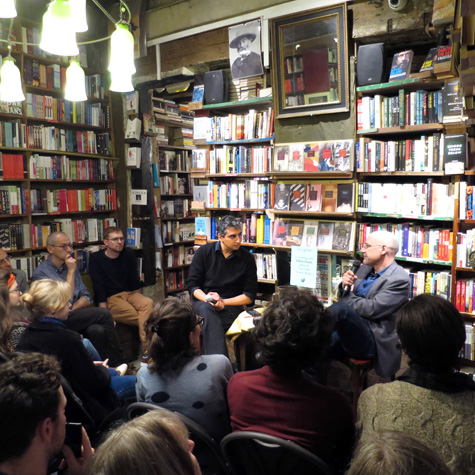
A conversation in Paris – with and about books
We’ve written about editor extraordinaire Daniel Medin of the American University of Paris, who is an editor for Music & Literature, The Cahiers Series, and The White Review. We’ve also mentioned Edwin Frank, editorial director of New York Review Books (and, incidentally, a Stanford alum), from time to time, since Stanford’s Another Look book club so often features NYRB’s books.
So we’re pleased the two of them got together for an interview last fall at Shakespeare & Company in Paris.
A few excerpts from the comprehensive Quarterly Conversation Q&A:
Daniel Medin: Could you tell us about the origins of NYRB Classics?
Edwin Frank: NYRB came into existence crab-wise, almost accidentally. I was in my mid-30s and had never had anything to do with publishing when I got a freelance job with a business associate of the New York Review called The Readers’ Catalog, a sort of a giant Sears Catalog of books. The idea was to sell the 40,000 best books in print. Independent stores were closing across the United States, so you could get The Readers’ Catalog and order the books you couldn’t find. And I got this job that basically consisted of reading through sections and saying “this shouldn’t be here” or “why isn’t this here?” The most prominent example that has stuck in my mind is that [Alberto] Moravia was pretty much completely out of print everywhere, this would have been around ’96. And lots of other things were out of print that I just thought by definition would be in print. I didn’t know why they weren’t in print, and since I didn’t work in publishing it took me a while to figure out that they weren’t in print because they wouldn’t sell. So I made a list and at some point made a proposal to the publisher of the New York Review, Rea Hederman, that effectively said, “maybe we should have a publishing project.” It took a few years to come together, but in 1999 we did come out with about 14 books, in a different design than we have now, a sort of disastrous design, but we survived that. And the books did better than anybody would have expected; I think we sort of went into it on tiptoes, but the response was more excited than I think anyone anticipated.
DM: I wonder about the vision of the project. You mentioned that the initial idea was to do reprints, so maybe you can talk about how it has developed since 1999.

He got into the venture “crab-wise.”
EF: The fact is, I really, really didn’t want to call the series “classics.” Who knows what a classic is? It’s difficult to explain to people in the States, and also to foreign publishers, where “classics” has a much more defined meaning. So it was difficult for a while to get people to understand that we weren’t doing new editions of Thucydides. But it’s just as well, or else we would have been arguing about the name of the series to this day. Anyway, from the beginning our goal was always to mix things up. Great literature is literature that remains news, and there’s a way to publish things that can cast a new light on things we take for granted in our own time. The metaphors I tend to think of are somewhere between the vinyl bin, where you can flip through and there’s a whole range of music and so on, or the repertory film theater that can move from Japan to B movies and so on. So that was always the idea, but at the beginning it was very much about reprints, and that was true for two or three years. Partly because the series was doing well there was a moment where it seemed right to begin acquiring books and doing new translations of books.
***

Daniel with Hungarian author László Krasnahorkai
DM: I’m curious as to how you’ve curated the lists from languages you cannot read. Hungarian literature, for instance. I happen to specialize in writing from that region—and your Hungarian list is remarkable. Anybody in this audience can go online and look at NYRB’s offerings, and if you pick a title and mention it to an author or cultivated reader from Hungary, they will acknowledge its importance. And Hungarian’s only one example among many in your catalog. What’s been the approach?
EF: Well, it varies. The Hungarian case is an interesting one because the language is so isolated that basically the Hungarian state commissioned a program of translating Hungarian literature into English. And the translators they employed were actually quite brilliant. (The Soviets also had that kind of program, but the translations were a lot iffier.) … one of my favorite books in the whole series is [Gyula] Krúdy’s Sunflower—a totally bizarre book, I’d never read anything like it. I mean it’s a book that . . . I used to compare it to a strange cross between Bruno Schulz and PG Wodehouse, with gypsy music kind of thrown in, funny and sexy and just odd. Like nothing I’d ever read. It’s not often you read a book that’s like nothing else you ever read. I sometime think if I read a book like that I should publish it, but sometimes that’s a mistake. Anyway, so for the most part [the Hungarian translations] haven’t been commissioned, and to get back to the larger question, you are dependent to an extent to the translators or the literary criticism.
Read the whole thing here. Or check out the video and podcast of the event at the bookstore’s website here.
Tags: Alberto Moravia, Bruno Schulz, Daniel Medin, Edwin Frank, Gyula Krudy, P.G. Wodehouse, Rea Hederman

